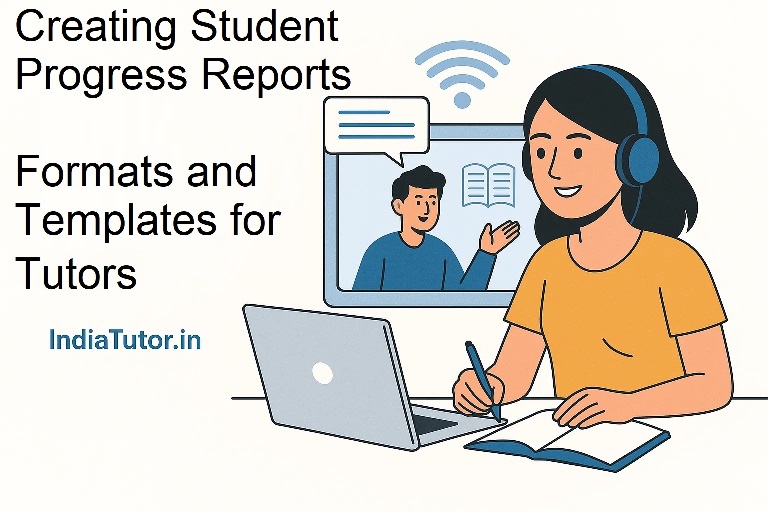Whether you’re teaching online or offline, tracking your students’ progress is essential for improving learning outcomes. One of the most effective tools for doing this is a student progress report. It helps tutors evaluate how students are performing, and it also gives parents and guardians clear insights into their child’s academic journey.
In this article, we’ll explore why progress reports matter, how to create them, the formats that work best for tutors, and share some simple templates you can start using right away.
Why Are Student Progress Reports Important?
Progress reports are more than just academic summaries. They’re a powerful communication tool between tutors, parents, and students. According to a 2023 study by the National Institute of Educational Planning and Administration (NIEPA), students whose parents received regular updates on their academic performance improved their grades by an average of 17% in one academic year.
Here’s what a well-crafted progress report can do:
-
Identify areas where students need help
-
Highlight strengths and achievements
-
Encourage parent involvement
-
Track long-term development over weeks or months
-
Build trust between tutor and parent
What Should a Student Progress Report Include?
Every student is different, and so are the goals of tutoring. But in general, a useful progress report includes:
-
Basic Details
-
Student name
-
Class/Grade
-
Subject(s) taught
-
Date of report
-
-
Attendance and Punctuality
-
Number of sessions attended
-
Timeliness and participation
-
-
Learning Objectives
-
Goals set at the beginning of the term/month/week
-
-
Performance Overview
-
Assessment scores (if applicable)
-
Concept clarity
-
Homework or assignment completion
-
Class participation
-
-
Tutor’s Comments
-
Personalized feedback
-
Specific examples (e.g., “Struggled with fractions but showed improvement in recent sessions”)
-
-
Next Steps
-
Areas to focus on in the coming sessions
-
Suggestions for practice or improvement
-
-
Parent Remarks (optional)
-
A space where parents can acknowledge the report or add observations
-
Common Formats Tutors Can Use
There’s no single “correct” way to present a student progress report. Here are some formats that work well for tutors:
1. Monthly Report Card (PDF or Print)
Ideal for tutors who want to share detailed academic updates once a month.
Example Format:
-
Subject-wise performance (Maths, Science, etc.)
-
Grade or marks out of 10 or 100
-
Tutor comments
-
Suggested action plan
2. Google Sheet Tracker
Best for long-term tracking and sharing live updates with parents.
-
Create columns for date, topic covered, understanding level, homework status, comments
-
Use color coding (Green for good, Yellow for average, Red for needs improvement)
3. WhatsApp Summary Report
For tutors who prefer informal but regular communication.
Example:
“Hi, here’s a quick update on Aryan’s progress this week:
-
Completed all algebra homework
-
Needs more clarity on linear equations
-
Great participation in class
Will focus on word problems next session.”
4. Progress Tracker via IndiaTutor.in
If you’re listed on IndiaTutor.in, you can use your tutor dashboard to update notes or progress if the feature is enabled in your profile tools. This makes sharing and record-keeping easy and transparent.
Simple Progress Report Template for Tutors
Here’s a basic sample you can use and adapt:
Student Name: Priya Sharma
Class: 6th Grade
Subject: English
Tutor: Nidhi Mehta
Reporting Period: 1st – 30th June 2025
Sessions Attended: 8/8
Attendance: Excellent
Learning Goals:
-
Improve reading comprehension
-
Practice written grammar and vocabulary
Performance:
-
Reading skills: Improved from Level 2 to Level 3
-
Vocabulary tests: Scored 80% average
-
Written assignments: Completed 90% on time
Tutor Comments:
Priya has shown strong improvement in comprehension. She participates actively in class discussions and is more confident in vocabulary use. Needs to focus more on sentence structure in writing.
Next Steps:
-
Focus on sentence formation and essay writing
-
Weekly reading tasks assigned for July
-
Grammar workbook exercises to be reviewed in next class
How Often Should You Share Progress Reports?
-
Weekly: Best for short-term or exam-focused tuition
-
Bi-weekly or Monthly: Ideal for long-term subjects and consistent tracking
-
End-of-term: Useful for summary reports for school-year wrap-up
A good rule of thumb is to match the reporting frequency to the student’s goals. If a child is preparing for a board exam, weekly updates can be useful. For younger students, monthly reports may be enough.
My Thoughts
As a tutor, your responsibility doesn’t end at teaching—it includes tracking and improving learning outcomes. A simple progress report can go a long way in demonstrating your professionalism, building credibility, and showing your genuine commitment to your student’s success.
Parents appreciate transparency. And students feel more motivated when their hard work is recognized. So if you haven’t started tracking progress yet, now is a great time to begin.
You can download free editable templates or use ready-made tools. What matters is that you start.
By Nidhi Mehta, Founder of IndiaTutor.in

